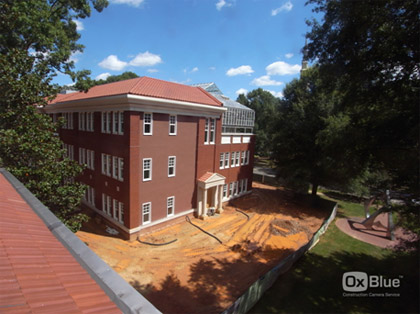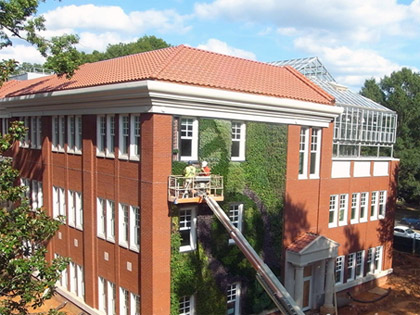Queens University of Charlotte: A Living Wall to Educate, Invigorate and Inspire
North Carolina’s Queens University of Charlotte was looking for a way to add design elements that were visually compelling and educational to the construction of its new $18 million Rogers Science and Health building. Captivated by the building’s greenhouse, architects opted to bring aboard a modern twist that celebrates environmental science while offering students an opportunity to live science not just learn from it.
Situation. Founded in 1857, Queens University of Charlotte, www.queens.edu, is a private, co-ed university located in Charlotte, North Carolina. The university serves approximately 2,400 undergraduate and graduate students through its College of Arts and Sciences, McColl School of Business, Blair College of Health, Wayland H. Cato, Jr. School of Education, James L. Knight School of Communications and Hayworth College for Adult Studies.
“As we add academic programs and extracurricular activities to meet the needs of our expanding student body, we’re also working hard to improve our beautiful campus,” says Bill Nichols, vice president, Campus Planning & Services, who has been overseeing the design and construction of the Rogers Science and Health building. “While remaining faithful to our beautiful Georgian style, we sought to invigorate and inspire our campus and add design elements that were not only visually compelling but educational too.”
Nichols, who ran his own architectural firm prior to joining Queens University, hired Little Diversified Architectural Consulting in May 2010 to create the construction documents. Matthews Construction was brought aboard in May 2011 to oversee construction.
Challenge. “Queens University of Charlotte has a very established architectural tradition,” explains Philip A. Kuttner, AIA, LEED, BD+C and chief executive officer of Little. “For the design of Queens’ Rogers Science and Health building, we sought to respect tradition while bringing aboard a modern twist which celebrated environmental science.”
Kuttner says they considered many sculptural ideas and were captivated by the building’s greenhouse where students will be able to monitor plant growth conditions and environmental factors in ways not possible in a traditional laboratory. After some deliberation, Little proposed the addition of an exterior green wall, which they felt could be visually compelling, environmentally responsible and also serve as an educational tool.
Reed Perkins, PhD, of the Environmental Science Department immediately embraced the green wall concept as a key teaching tool for his students in the Rogers building. He says, “A living wall can offer an opportunity for our students to truly live science not just learn what others have done. From the beginning, the faculty wanted even the most casual observers of the university to see that this building was a place of science, discovery and imagination.”
Little recommended Ambius, a global interior and exterior landscaping company, www.ambius.com, to install the living wall because of their vast experience designing and installing some of the most expansive living walls ever created.

© Vorticom
Two of Ambius’ lead designers, Denise Eichmann and Mark Hawry, began the project in fall of 2011. Eichmann, who has created some of the countries’ most beautiful and distinctive landscape designs, has award-winning expertise in the design, construction and installation of vertical gardens and living walls.
“Dr. Perkins was the originator of the green wall’s plant pattern, which is a DNA double helix strand. Working with Dr. Perkins, his colleagues and the architect firm, we produced four drawings with recommended plant species and plant design for the spring, summer, fall and winter living wall prototype,” says Eichmann.
Perkins explains that “part of our green wall message is that DNA is always with us, and as the DNA strand is made of evergreen, we have a living statement that the fundamentals of life are always with us.”
Eichmann says it was important that the plant species were noninvasive so they labeled plants as “red” light (too invasive or not indigenous), “yellow” light as possible contenders and “green” light for the top recommendations. After the plants were selected, she and her colleagues started the design and plant acquisition process.
The plants were grown at the Twixwood Nursery in Berrien Springs, Michigan. Steel panels were plugged in with the different plant species, which remained in the nursery for 16 weeks to grow into their panels. Then they were shipped to the site for the Ambius team to install.
“A vertical green wall is an unnatural growth environment for plants in terms of drainage, solar input and other factors. Plants that do well in high-stress environments are often invasive. Ambius worked collaboratively with us, patiently and enthusiastically, to identify plants that were able to tolerate those unique conditions and not disrupt the surrounding vegetation communities. We weren’t so much concerned that the plants were native to North Carolina as with whether the plants would invade the surrounding landscape,” comments Perkins.
The installation of the green wall took about two weeks. “It was fascinating to watch the installation process. The wall is 24 feet wide and 35 feet tall, and there were 693 standard panels and several custom panels, so ensuring the right plant was placed in the proper place was crucial. Each plant container was numbered, and Ambius followed their chart, which showed exactly where to put each container on the wall,” comments Nichols.
The living wall features 14 plant species, including Carex (sedges), Polystrichum (christmas fern), Heuchera (coral bells), Sedum (stonecrop), English Lavender, Gelsemium (yellow jasmine) and Hellebore (Lenten rose).

© Vorticom
“Ambius was able to deliver a truly turn-key system and were great partners to work with. We had never been involved with a green wall of this size and magnitude before and were happy to report that thesystem was installed and working beautifully just as projected,” says Michael Heavner, project manager, Matthews Construction.
Results. The living wall at the Platinum LEED-certified facility is now directly involved in teaching about environmental conservation. Queens University of Charlotte is demonstrating conservation as the abundance of green design features ensures students learn both in and from the building. Its green wall features non-invasive plants that keep the building cool.
“The students understand how living walls come complete with their own ‘life support’ system, which is comprised of a supporting structure to hold the plants vertically, a growth medium to ensure plant longevity, an irrigation/fertilization system to deliver the correct amount of water and nutrients, and a drainage system to properly re-circulate the spent water. They understand how proper selection and design of a system for a particular locale necessitates plumbing and electrical considerations. Finally, this living wall at the Rogers Science and Health building serves as the front porch of the university,” concludes Perkins.




























